The UNESCO World Heritage Site of Hampi in Karnataka, India is well known as the seat of power of the powerful Vijayanagara Empire. Hampi with its historical monuments like the Virupaksha Temple, Vittala Temple, Bazaar Street, and other architectural gems is well known. But did you know that on the opposite bank of the river Tungabhadra stands Anegundi village?
Anegundi village is a place that stands in the perpetual shadow of Hampi. A place that was once the centre of the Vijayanagara Empire, even before Hampi. So if you travel beyond Hampi and cross the Tungabhadra river you come to the amazing place which is strewn with gems from history and mythology. It is a place that is older than Hampi.
Though a part of the other bank of the river is known for being a backpacker haven, referred to as the Hippie Island, not many know about Anegundi, which with its treasures of history and heritage remains for the most part unexplored.
This post hopes to be a complete guide to Anegundi village, its history, and the best places to visit in Anegundi and its vicinity.
Table of Contents
Anegundi Village – 4 Billion Years Of History Near Hampi
The Anegundi Village stands as a lost chapter of history, awaiting its tryst with destiny, a place that has recently awoken from slumber. It is a place where history and mythology confront you in almost each and every godforsaken corner.

Anegundi Village and the vicinity is part of one of the oldest plateaus on earth. In fact, according to Geologists, the Anegundi Village and the area around it are as old as our planet itself. It is said to have now existed for more than 4 billion years. Traces of Neolithic history, Microlitihic history, and Megalithic history can be found near Anegundi.
Anegundi Karnataka is a fascinating medley of history, mythology, heritage, and even geology. From primitive Neolithic paintings to the architectural monuments of the Vijayanagar period, Anegundi stands as a mute witness to the march of time.
Join us on a virtual journey into the fascinating world that exists in Anegundi village and its surroundings.
Travel back in time to Anegundi – Hampi and Beyond

The car sped along a road flanked by the ubiquitous boulders of Hampi. Our destination was Anegundi village which is on the northern bank of Tungabhadra River.

One can cross the river in a boat or travel by road across the Anegundi bridge that spans the river.

However, it had rained heavily the previous week and the river was in full flow, so the option of crossing the river on a coracle locally called a Theppa was ruled out.
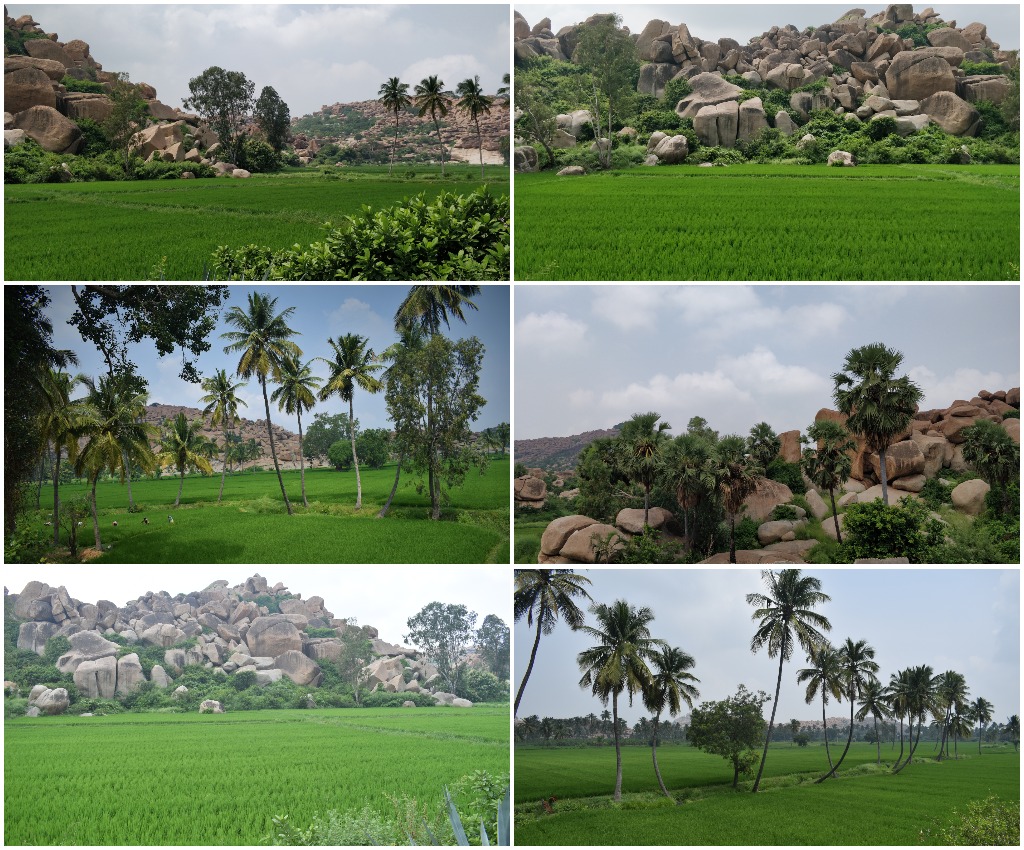
Soon we approached the Anegundi bridge and drove across the river. The earth stretched out like a palet overflowing with green. The lush green paddy fields interspersed with coconut trees presented a picture that was soothing to the eyes. The brown boulders with clear blue skies dotted with white fluffy waves only added to the magic.
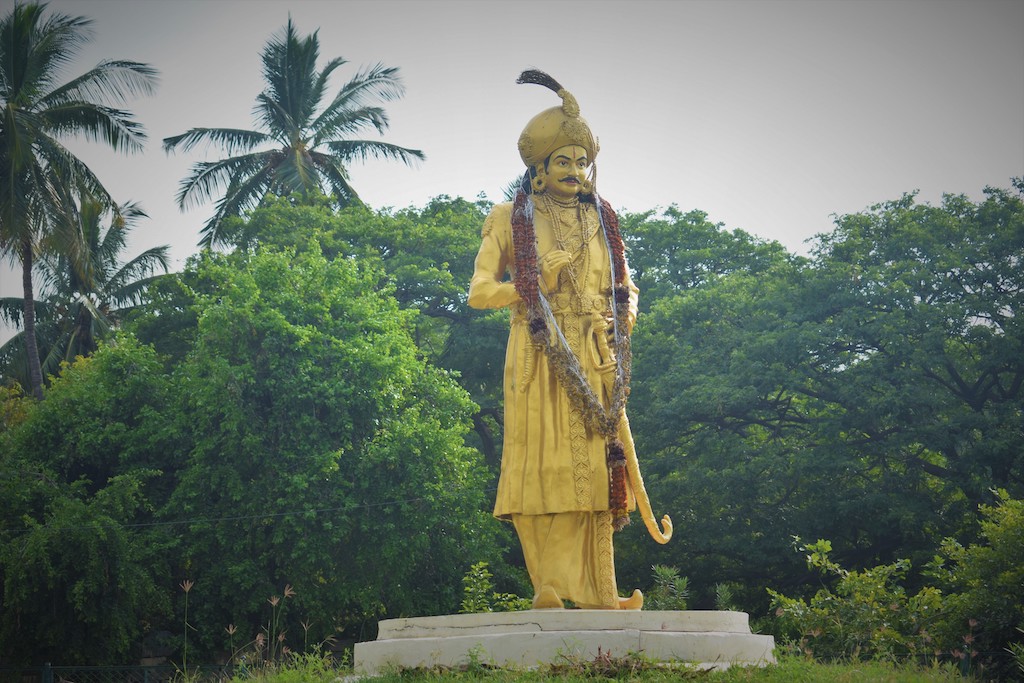
The appearance of the statue of Sri Krishnadevaraya, the most famous of the Vijayanagara rulers of the Vijayanagara Empire who lived in the 16th century, heralded our arrival at Anegundi village. The statue stood at the entrance to the village like a silent sentinel. Just behind the statue was located the remains of a stone wall and a stone structure supported by pillars.
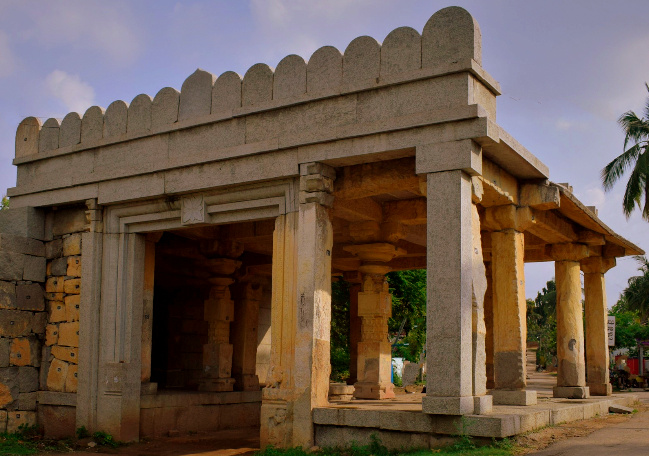
This we learned was the ancient entrance to Anegundi village and was known as Modaline Bagalu, which in Kannada means, “First Gate”.
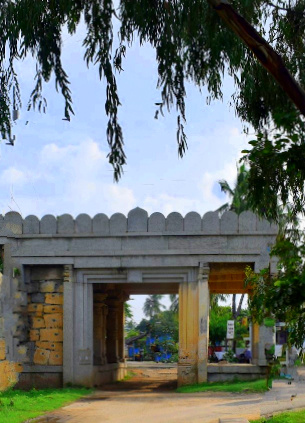
We passed the Modaline Bagalu and entered a world that took us back in time and opened windows to different chapters of history in Anegundi village.
Anegundi Sightseeing – Places to See in Anegundi
Sightseeing in Anegundi is an experience that leaves indelible memories. The lush greenery that is a marked contrast to the rocky terrain provides an enchanting setting as you immerse yourself in the forgotten chapters of history in and around Anegundi village. Read on as we experience one amazing sight after another on our Hampi Anegundi tour.
Navabrindavanam Anegundi
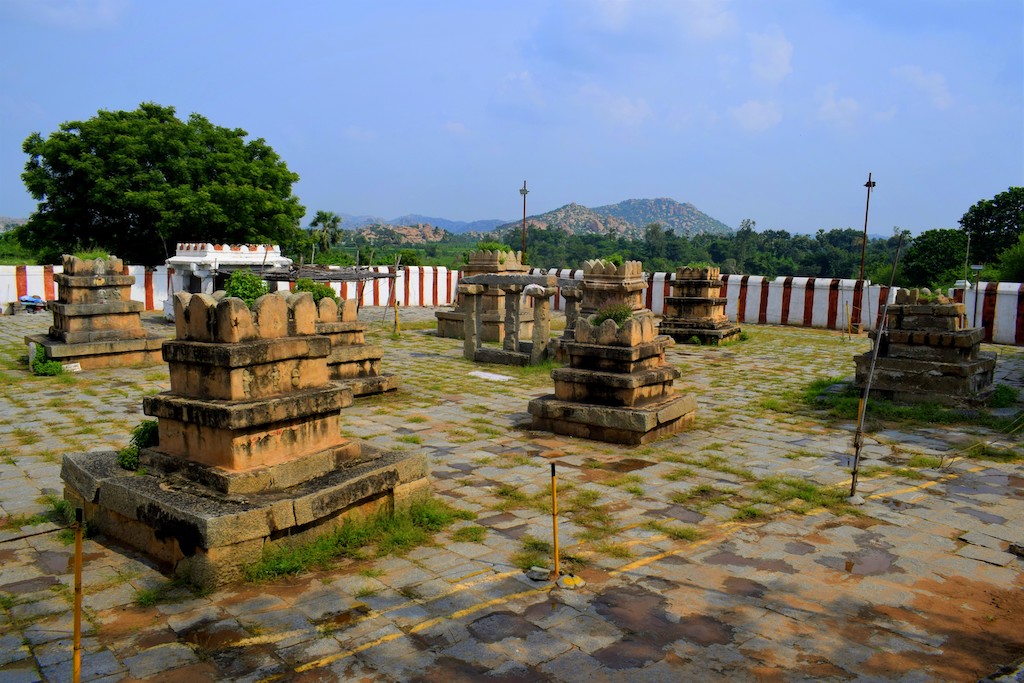
A boat stood anchored near the shore. A couple of boys were playing nearby. They ran off to call the boatman when we made enquiries about the boat. We were on the northern banks of the river Tungabhadra in Anegundi village and wanted to reach an island in the middle of the river where stands the Navabrindavanam.
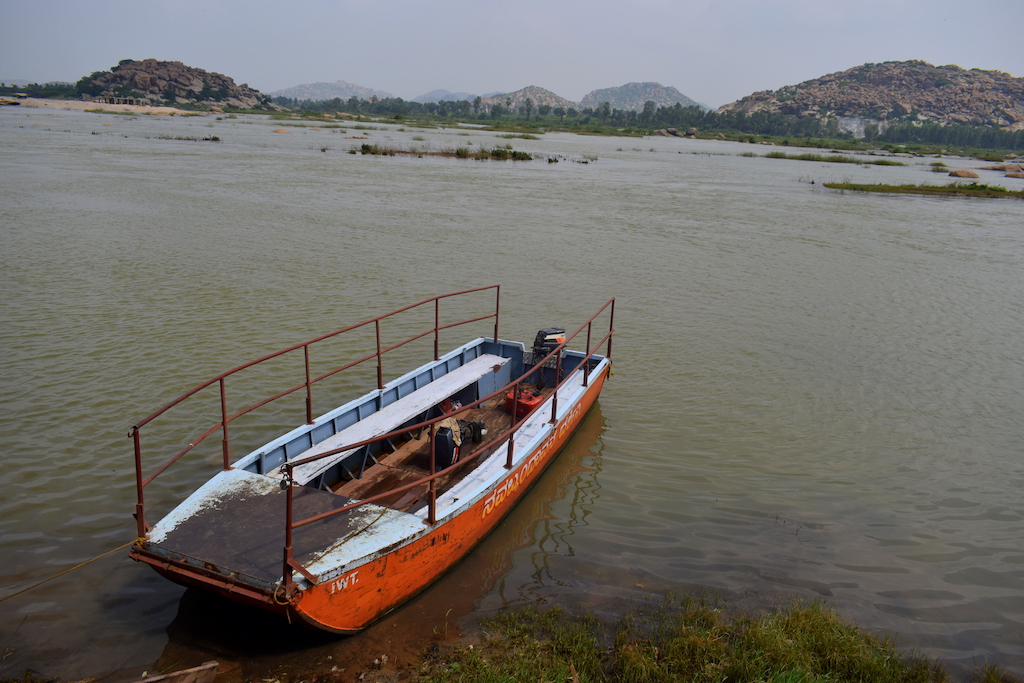
To our relief, the boatman soon arrived and the good news was that the boat would ply. After picking us a few more passengers off we went into the water. The boys perched towards the front of the boat, like helmsmen. We were fascinated to learn that the boys were brothers. One was named Sugriva and the other Vali!
Not surprising considering we were in Ramayana territory, but more of that later.
We reached an island and made our way through rocks to a small place enclosed by a wall. This was the Navabrindavanam of Anegundi.

Navabrindavanam is a sacred place. It has the Jeeva samadhis of 9 Madhava saints and hence the name Navabrindavanam. Nine Brindavanas, with one in the centre and the others encircling it form the Navabrindavnas. The Samadhi in the centre is that of Sri Padmanabha Teertha who was a direct disciple of Madhavacharya. The other samadhis are of Sri Kaveendra Teertha, Sri Vageesha Tirtha, Sri Vyasraja Teertha, Sri Raghuvarya Teertha, Sri Sreenivasa Teertha, Sri Rama Teertha, Sri GovindaVadeyaru, and Sri Sudhindra Teertha who was the Guru of the famous saint Raghavendra Tirtha, better known as Sri Raghavendra Swami.

Navabrindavanam is a historic place considering that the oldest samadhi dates back to 1324. It is also a sacred pilgrimage place for the Hindus. One of the Samadhis had been desecrated by vandals in search of ancient hidden treasures in 2019, but the Samadhi has been restored. It may be noted that there are no priests stationed at Navabrindavanam. They stay at the Anegundi Mutt (Sri Raghavendra Mutt), they go to the island, and after finishing the daily ritual puja return back to the mainland at Anegundi village.
64 Pillared Mantapa – Krishnadevaraya’s Samadhi?

As we waited for our boat to leave for the Navabrindavanam, we spotted an intriguing structure, that looked perfectly symmetrical not far from the shore. The structure was partially submerged by the waters of the Tungabhadra. It was an open pavilion, a classical Mandapa (Mantapa) of Indian temple architecture. The structure is supported by 64 pillars and hence the name 64 Pillared Mantapa. The structure is an open-air hall supported by an array of pillars. The 64 pillars are said to represent 64 arts including dance, music, etc., which were patronized by the rulers of the Vijayanagara empire, chief among them being Krishnadevaraya.
There is a myth that the place is actually the samadhi of Krishnadevaraya, however, there is no historical evidence of this fact. The location of Krishnadevarayas Samadhi is a mystery as no inscriptions to this effect have been found.
Gagan Mahal – Anegundi Palace
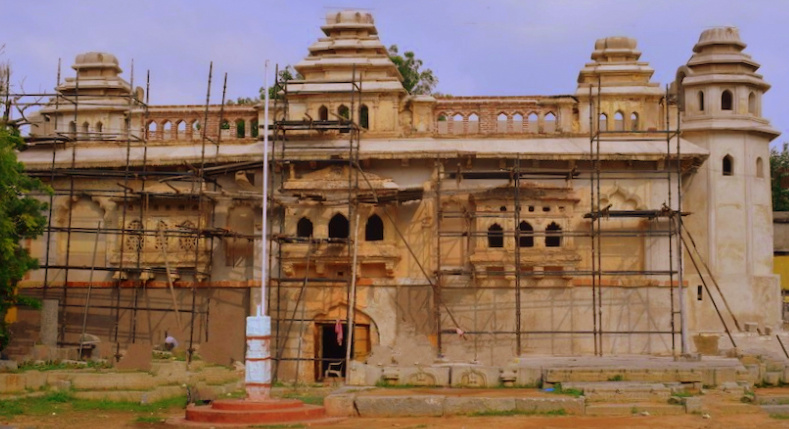
The Gagan Mahal which is also known as the Anegundi palace or Old Palace is a small and simple structure right in the middle of Anegundi village. However, when you take a closer look, the finer points of the architectural design become evident. The Gagan Mahal was the royal quarters of the Vijayanagara rulers when Anegundi was the capital before the emergence of Hampi. The building has elements of Indo-Islamic architecture. The Gagan Mahal which was in ruins is being restored.
One of the noteworthy features of the Gagan Mahal is the exquisite and decorative windows and balconies that out on an open space. It is believed that members of the Anegundi royal family used to watch entertainment programmes from these balconies.
The Kingdom of Kishkinda – Anegundi Village And The Ramayana Trail
Ramayana, one of India’s great epics is a saga of Lord Rama and his quest for his wife Sita, kidnapped by the demon king Ravana. One of the pivotal portions of Ramayana is the Kishkinda Kanda in which Shri Ram meets Sugriva and Hanuman.
It is believed that the place called Kishkindha in the Treta yuga, which was the kingdom ruled by the Vanaras, Sugriva and Vali was in the vicinity of the present-day Anegundi village. There are many places associated with incidents from the Kishkinda Kanda in and around Anegundi.
Vali’s Fort – Anegundi fort Hampi
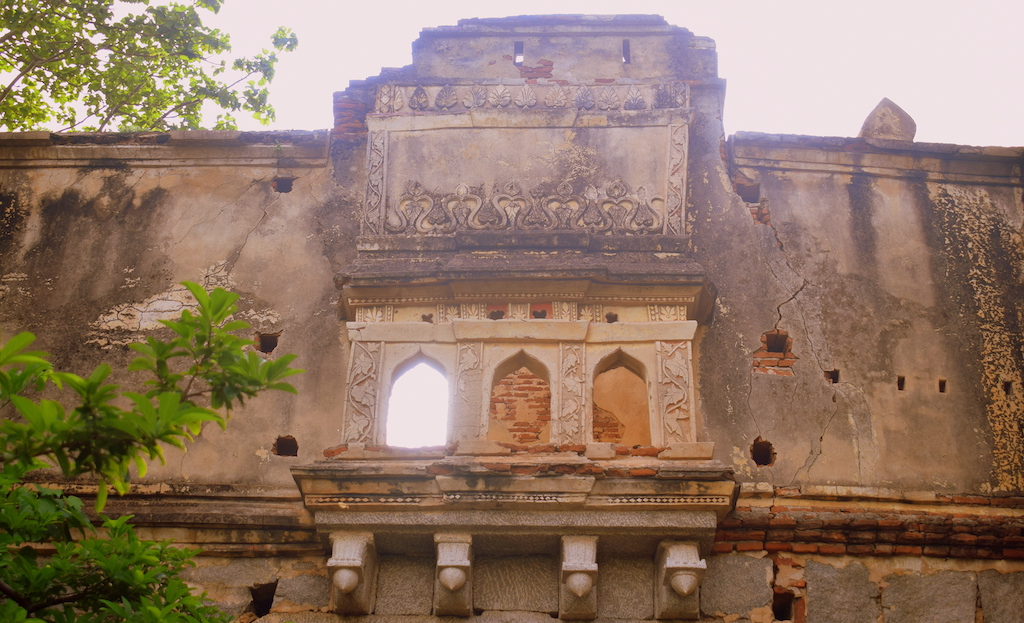
The car drove up to the foot of a hill. We then took the flight of wide steps brightly painted in red and white that wound its way upwards amidst rocks and boulders. After a short climb, we reached the Durga temple which looked quite colourful, but we continued our trek which took us to a path behind the temple.

There were no steps now, it was just a plain and rocky path that we followed. A local who worked in the temple assumed the role of a guide and led us up the rocky path. Huge rock formations with intriguing shapes could be seen everywhere.
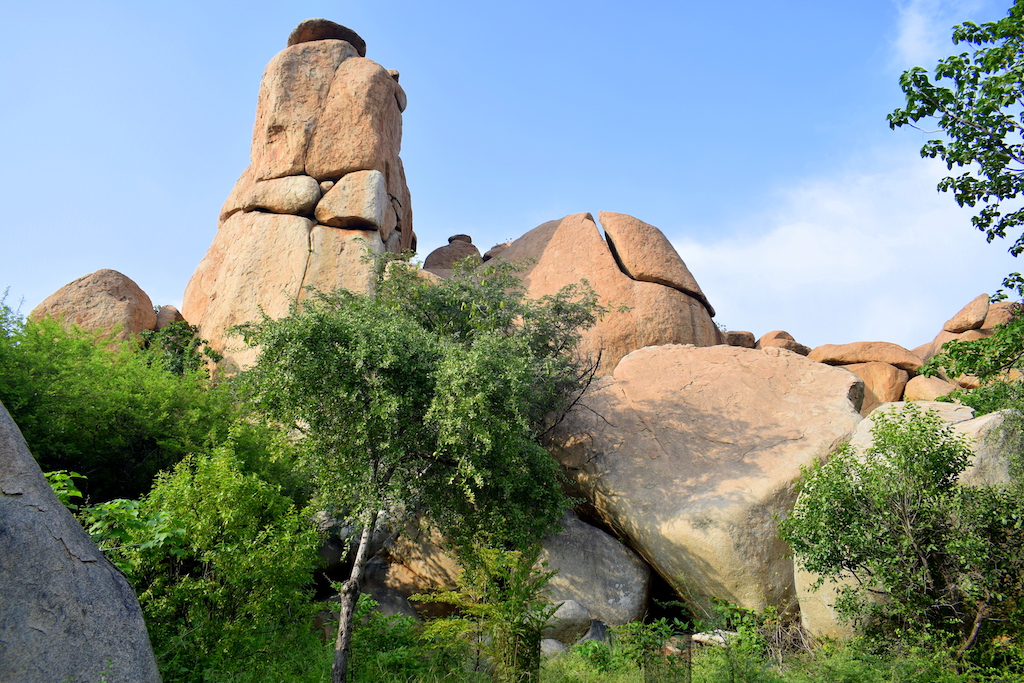

A particular rock formation that looked uncannily like a human face had our attention riveted. But we trudged on, following in the footsteps of our self-proclaimed guide who was asking us to keep moving with a gesture of his hand.
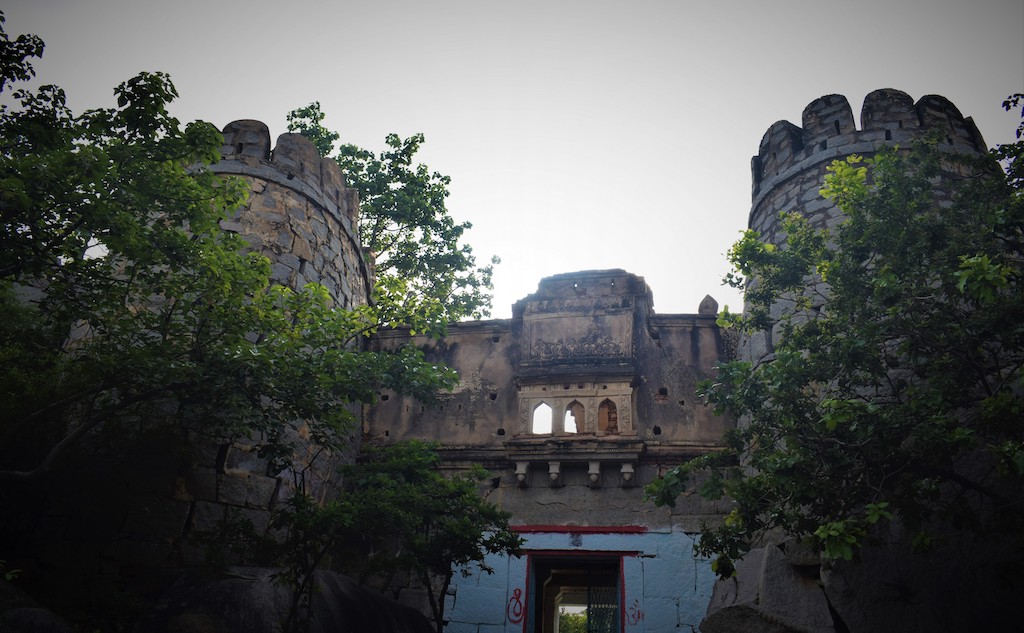
Soon we spotted a small doorway set in the middle of an imposing fort flanked by two turrets. In the centre of the structure was a balcony that was similar in design to the ones at the Gagan Mahal. “This is Vali’s Fort”, said our self-proclaimed guide, gesturing at the fort which is also known as Anegundi Fort. As we gazed up at the structure that loomed in front of us, a couple of tiny monkeys scampered away from the balcony ledge of the fort.
The Anegundi Fort is historically dated to the time of the Vijayanagara empire though local lore may associate it with Vali. It could be that there may have been an earlier old fort in the same location, but that is a matter of conjecture.
Tombs of The Royal Family
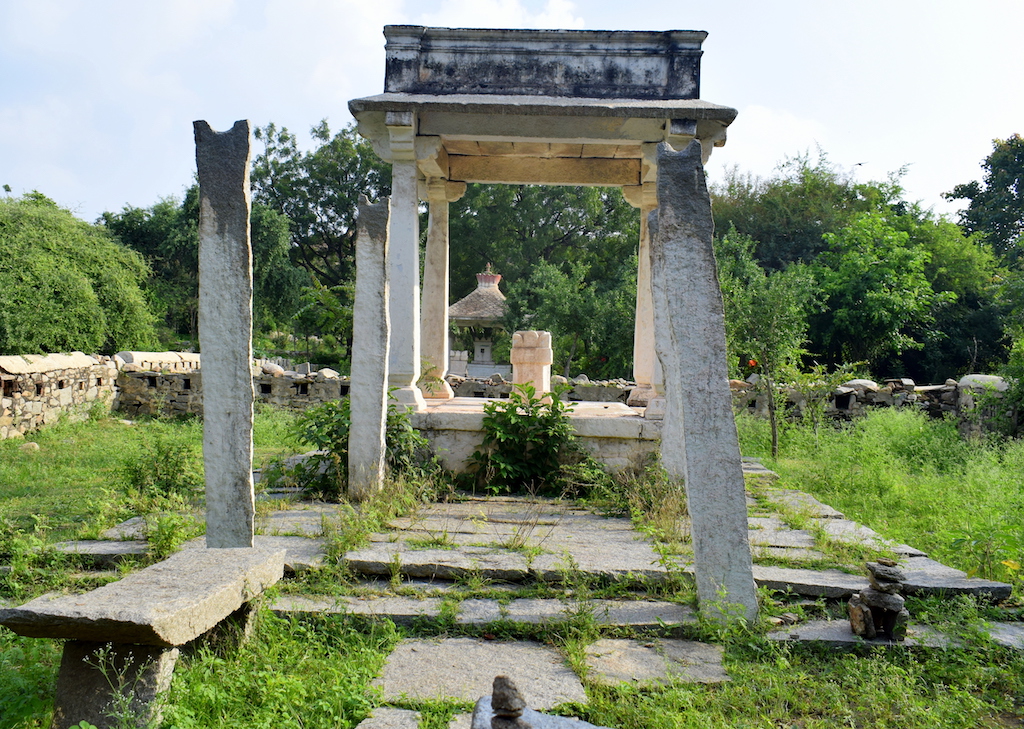
We continued onwards from the Anegundi fort, our self-styled guide, still leading the way. Towards our left we spotted what looked like tombstones, the place was shrouded in a sepulchral calm. “Those are the tombs of the royals of the Vijayanagara empire“, said our guide, as if reading our mind. The tombs are believed to be those of different family members of the rulers of the Vijayanagara empire.
Vali’s Cave
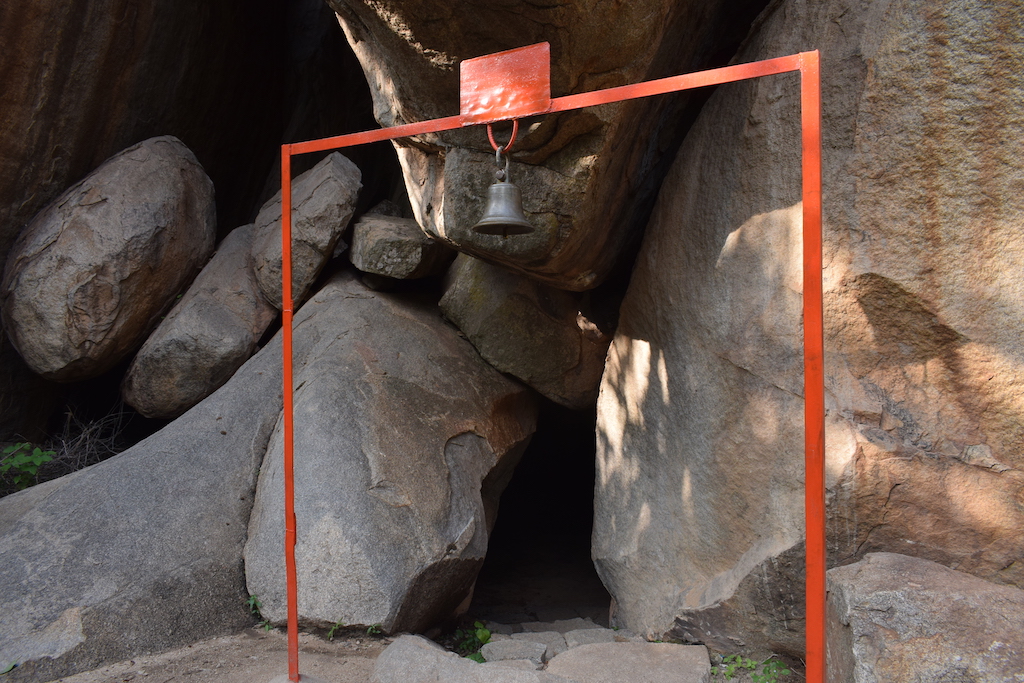
After passing the tombs of the royals, we reached a small Ganesh temple, and behind the temple lay a dark cavern that encircled the temple. We followed our guide into the rocky cavern which was pitch dark. We switched on the torchlight on our mobile phones to navigate through the dark and damp path.
Huge boulders made up the wall of the cavern. As per local legend, behind one of these boulders, there is another passage and it was this passage that Vali entered while chasing a demon called Mayavi. Legend has it that Vali asked his brother Sugriva to stand guard at the entrance to the cave. Vali chased the demon deep into the cave and a fierce battle ensued between them while Sugriva stood guard outside.
Even after a long time, Vali did not come out, it was then that Sugriva saw blood flowing out of the cave. He thought that the demon had killed Vali, so he quickly blocked the entrance to the cave with a massive boulder, and went home, and announced the death of Vali.
Pampa Sarovar Near Anegundi
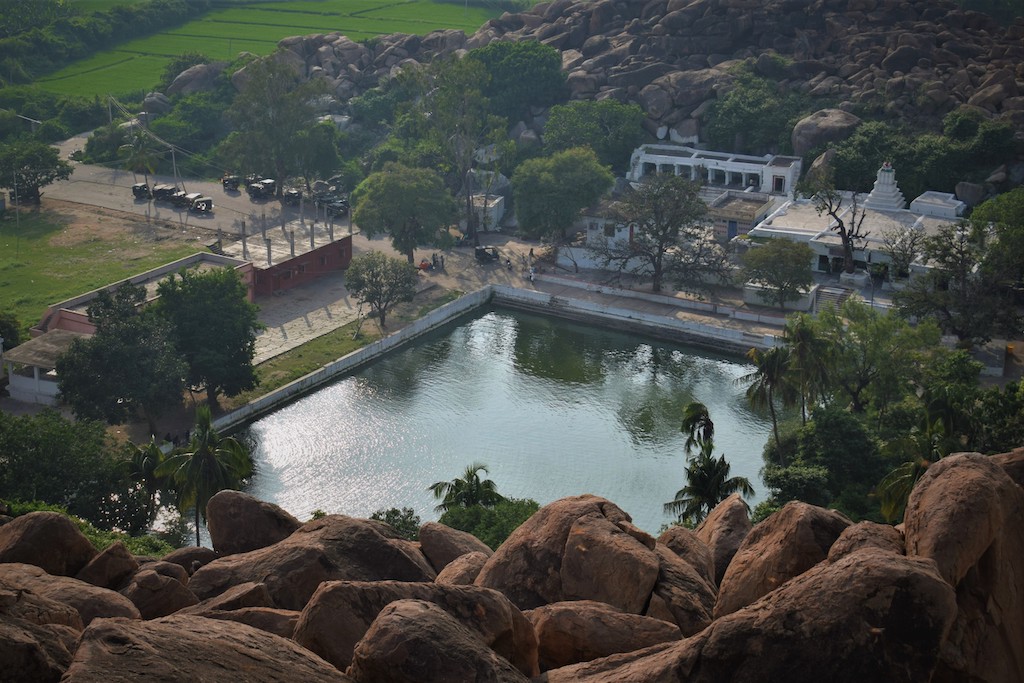
Oh! Soumitri, magnificent is Pampa Lake with its cats-eye gem-like waters, and she with her fully bloomed lotuses and costuses is beaming forth, along with many trees around her.
Shri Ram to Lakshman on seeing the Pampa Sarovara in the Kishkindakanda of Ramayana
This is how the Pampa Sarovar was described by Shri Rama in the Ramayana. The Pampa Sarovar is a beautiful lake with a few temples on its banks. It is believed that when Ram and Lakshman were wandering in the forest in search of Sita, they met Shabari who directed them towards the Pampa Sarovar to seek help from the Vanaras of Kishkinda.
The Pampa Sarovar is considered to be a very sacred lake. It is one of the five sacred lakes that are mentioned in the Shrimad Bhagavata Purana, as Panch Sarovar. The other lakes are Manasarovar in Tibet, Bindu Sarovar in Siddhpur, Gujarat, Narayansarovar in Gujarat, and the Pushkar Lake near Ajmer in Rajasthan.
The Birthplace of Hanuman – Anjanadri or Anjaneya Hill

The connection that Anegundi has with mythology ensures the pre-ponderance of temples in Anegundi. One important Anegundi temple that has been attracting the attention of visitors is a small Hanuman temple. This temple stands atop a hill known as Anjaneya Hill or Anjanadri Hill or Anjanadri Betta. It is believed that Anjaneya or Hanuman, the great devotee of Shri Ram was born here. One can trek up to the hill to see the temple, a bonus is the spectacular views from the top. It would take about 3 to 4 hours to climb the mountain and return back to base.
It is really interesting to note that stones from Anjanadri Hill would be used in the building of Ayodhya’s Ram Temple as a symbolic gesture.
Chintamani Shiva Temple
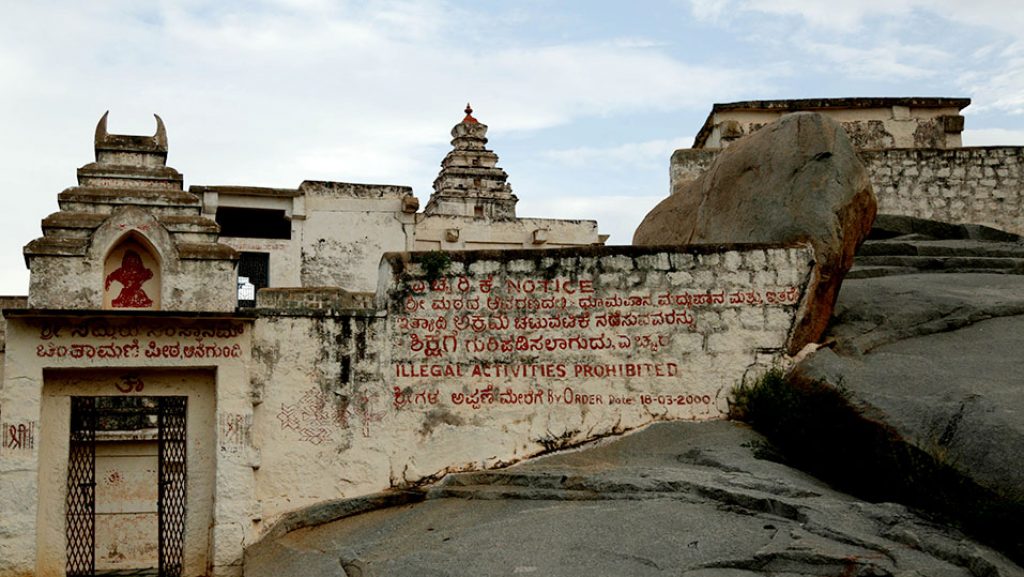
The Chintamani temple in Anegundi village is another temple that is associated with the Ramayana. It is believed that Shri Ram met Sugriva and Hanuman near here. There is a stone here which is believed to have been the one on which Shri Ram sat while speaking to Sugriva. A place where Vali was killed by Shri Ram is also in the vicinity.
A saint is believed to have lived here in later times and built a Shiva temple. There is a Shiv Ling here which has a Sri Chakra on top, which is unique in itself. Legend has it that the saint who lived here disappeared inside a chamber below the Shiv Ling, never to be seen again.
Durga Temple
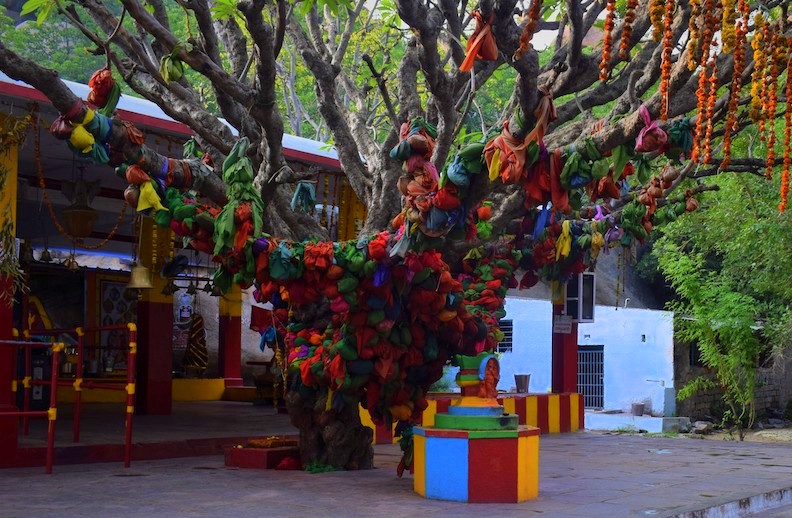
The Durga temple is an ancient temple, which you come across while proceeding towards the Anegundi Fort. A huge tree festooned with colourful bands of cloth tied by the devout stands in front of the temple.
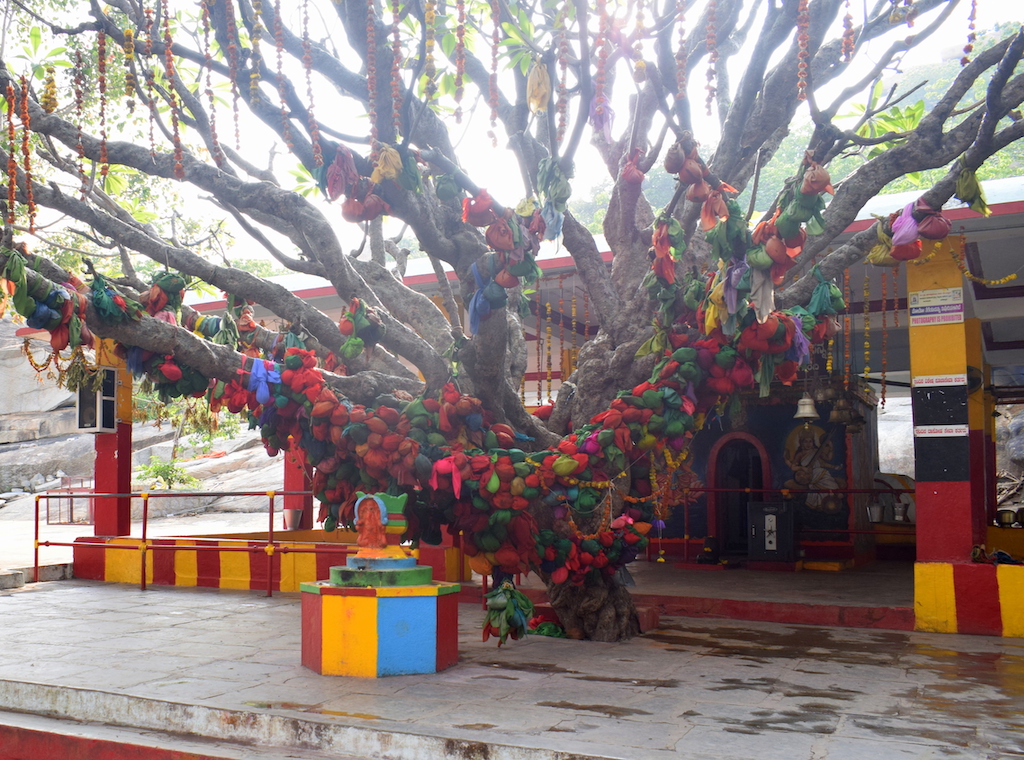
It is the very temple in which the kings of the Vijayanagara empire worshipped. It is believed that they worshipped the Goddess in this temple before embarking on their military ventures.
Ganesha Temple
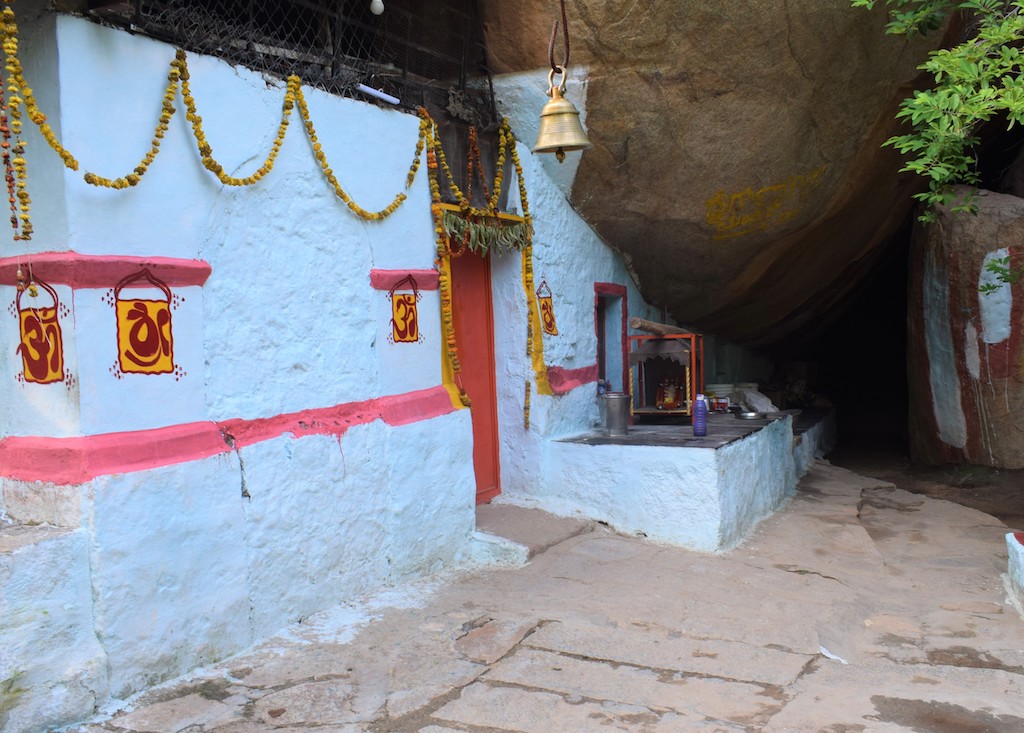
The Ganesha temple is at a little distance from the Durga temple. It is a small cave temple that is located on the outer side of the Vali cave.
Subramanyaeshwara Temple
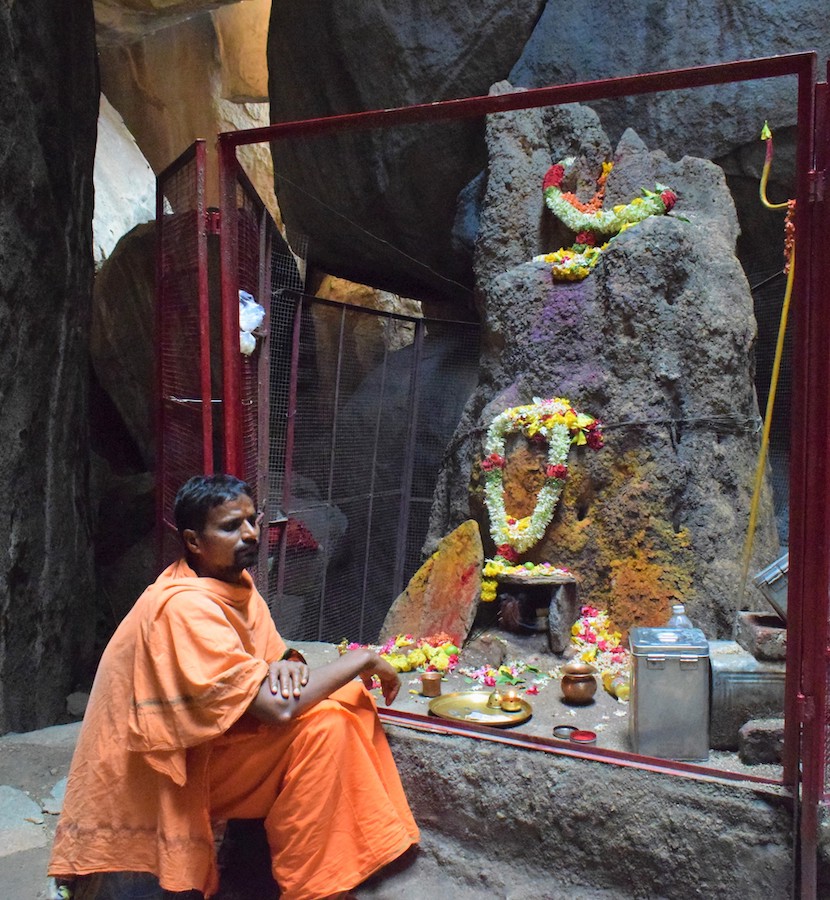
Once you have passed the Durga temple and the Ganesha temple, the path becomes tougher. In fact, there is no discernible path. One needs to step over assorted rocks and boulders until you reach the summit of the hill. Here the land is surprisingly flat and you can see rocks everywhere. One can also get a spectacular view of the enchanting Pampa Sarovar and the temples on its banks.
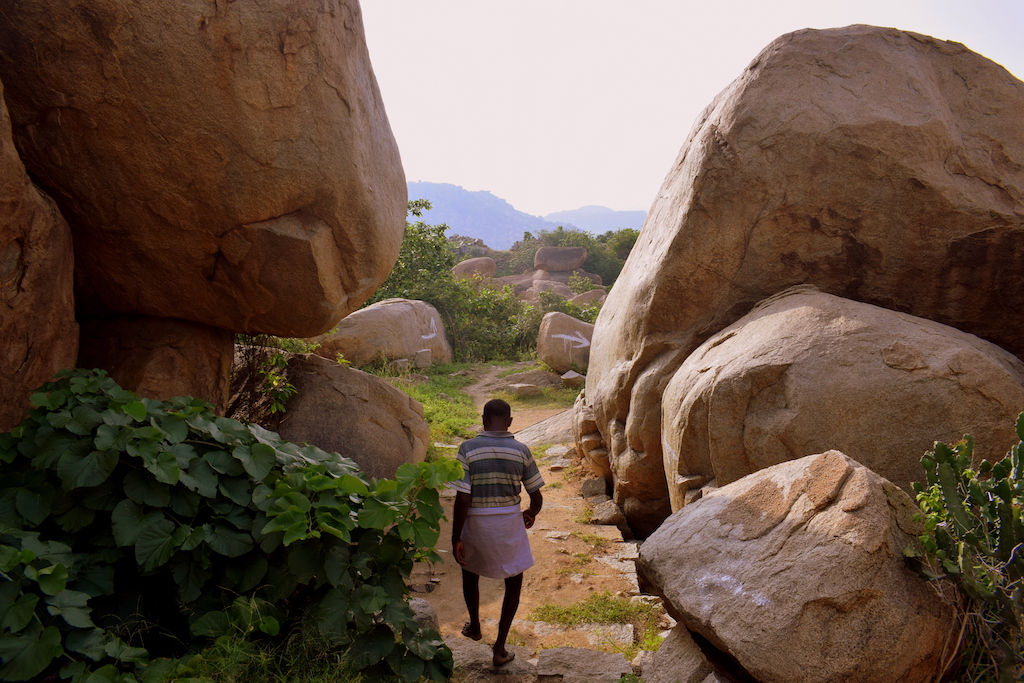
A board reads, “Sri Subrahmanyeshwar Temple“, “Leave your footwear here”. We leave our footwear near the board and follow our guide who disappears below the ground. As we catch up with him, we realize that he is descending into some kind of a cavern in the rocks, literally a hole in between the rocks. We follow him, sometimes sliding, sometimes crawling down. part of the descent is facilitated by steep iron steps, while part of the way one has to fend for themselves.
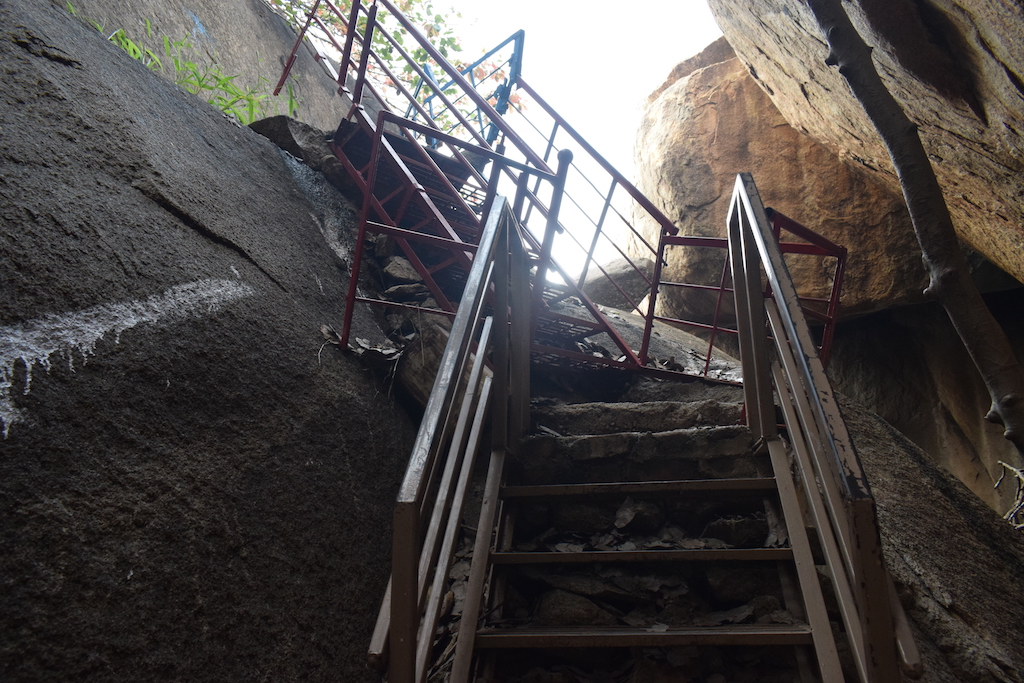
We soon reach a dark subterranean cave in the midst of the rocks. There stands a huge anthill, which is the centre of attraction, the deity worshipped in the temple.
The Subrahmanyeshwar Temple is not to be confused with a Subrahmanya temple. It is said that a saint by the name of Subrahmanyeshar meditated in the cave and so deep was he in meditation that the anthill was formed over him. This temple near the Anegundi village was one of the most amazing and unique temples we have visited and it did remind us of another mysterious temple, the temple of Patal Bhuvaneshwar in Uttarakhand.
Pampa Sarovar Laxmi Temple
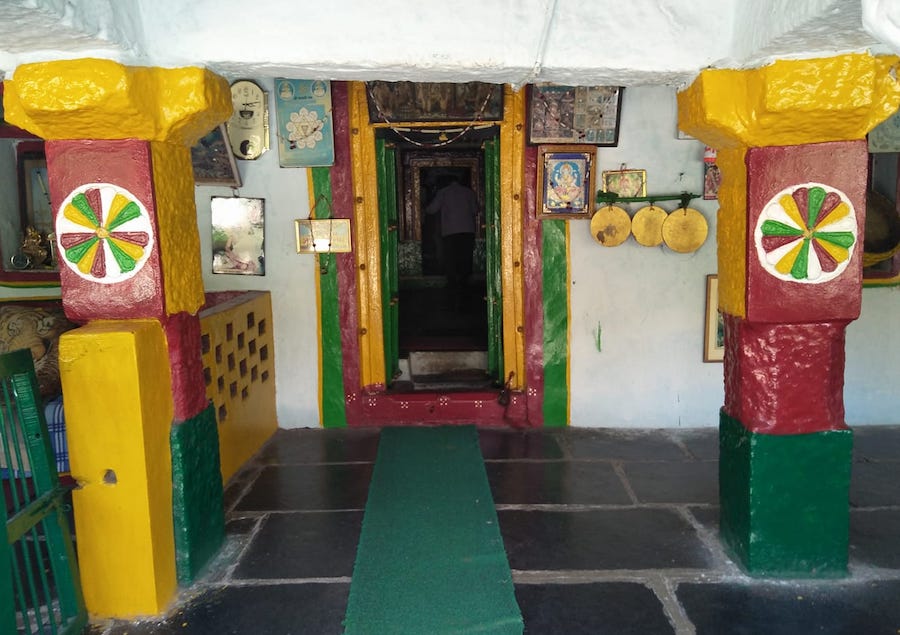
The beautiful Pampa Sarovar is an enchanting lake full of lotuses. On the banks of the lake is an ancient Lakshmi temple which was also a temple regularly visited by the royal families of the Vijayanagara empire. Along with the Lakshmi temple, there are also temples dedicated to Shiva and Ganesha on the banks of the Pampa Sarovar.
Anegundi Lord Ranganatha Temple
The Ranganatha temple of Anegundi village is another historical landmark of the place. The temple is dedicated to Vishnu, who can be seen in the reclining position (Ananthasayanam) on Adishesha, the divine serpent. The temple is small but has immense historical and architectural value. The Ranganatha temple too is located in the centre of the Anegundi village not far from the Gagan Mahal. A chariot that is used during Rath yatra or car festival stands near the temple. the Ranganatha temple too was frequented by the rulers of the Vijayanagara empire.
Mourya Mane
If you travel a few miles from Anegundi, you take a giant leap back in time to the Neolithic period. Here one finds megalithic dolmens. The dolmens are formed by sheet rocks that are about four to seven feet in height and support a roof which is again of a rock sheet.
Onke Kindi
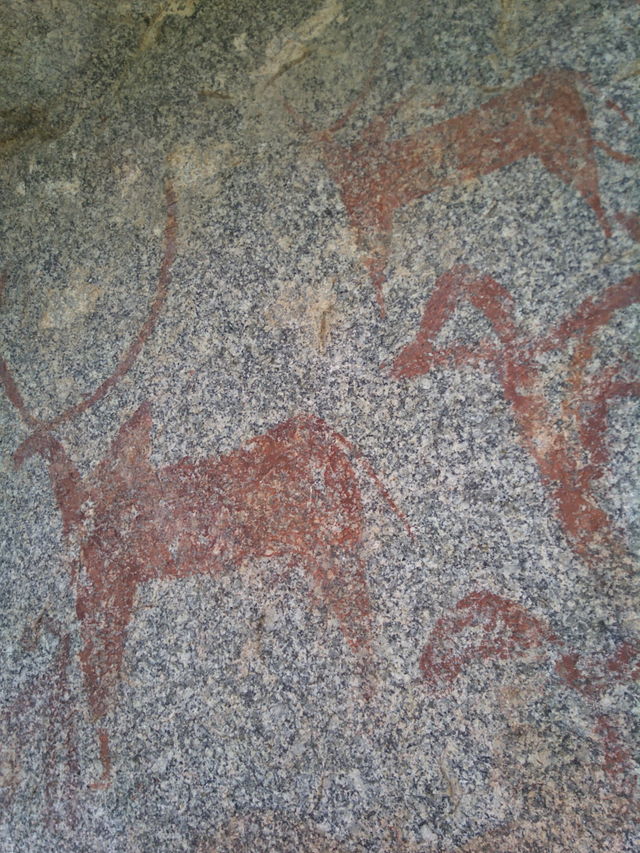
Evidence of a prehistoric settlement is found very near Anegundi village at a place known as the Onke Kindi. One can find rock paintings that depict animals, humans, and different symbols.
The Kishkinda Trust – Transforming Anegundi Village

The Kishkinda Trust which is based in Anegundi Village has been a catalyst in the transformation of the socio-economic fibre of Anegundi.
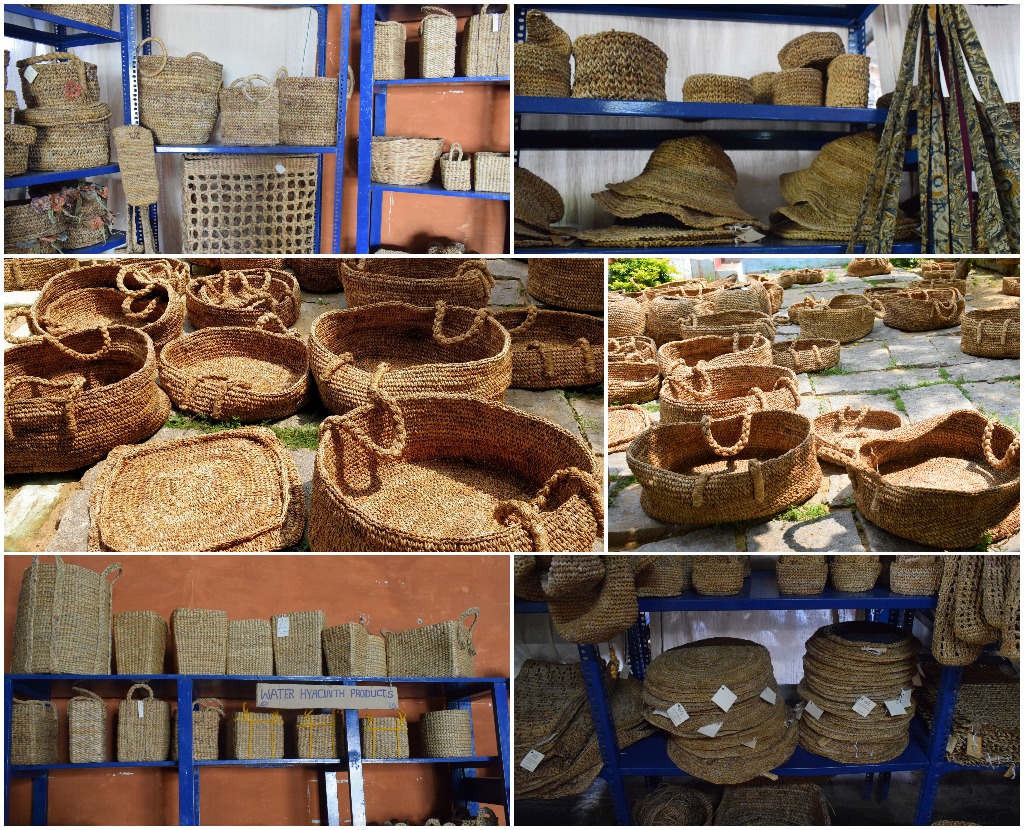
The Kishkinda Trust works with the local women and empowers them through meaningful employment and socio-economic development. The women of Anegundi make various items like hats, baskets, and other items from Banana Fibre, which are then sold in India and even abroad.
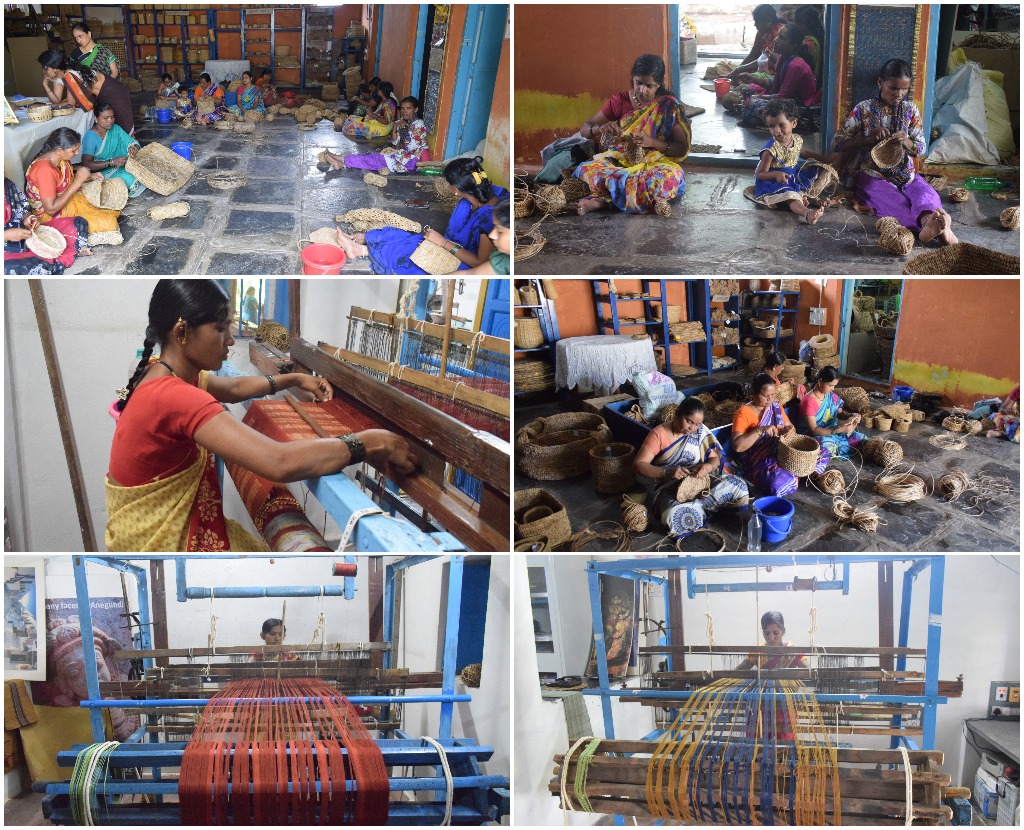
The Kishkinda Trust also is involved in projects for the preservation of the heritage of Anegundi and the development of eco-tourism in Anegundi village.
Anegundi’s Royal Legacy

Descendants of the royal lineage of the Vijayanagara empire are still around in Anegundi. A 250-year-old ancestral mansion has been renovated by Sri Krishna Deva Raya who happens to be a direct descendant of the king Krishnadevaraya.
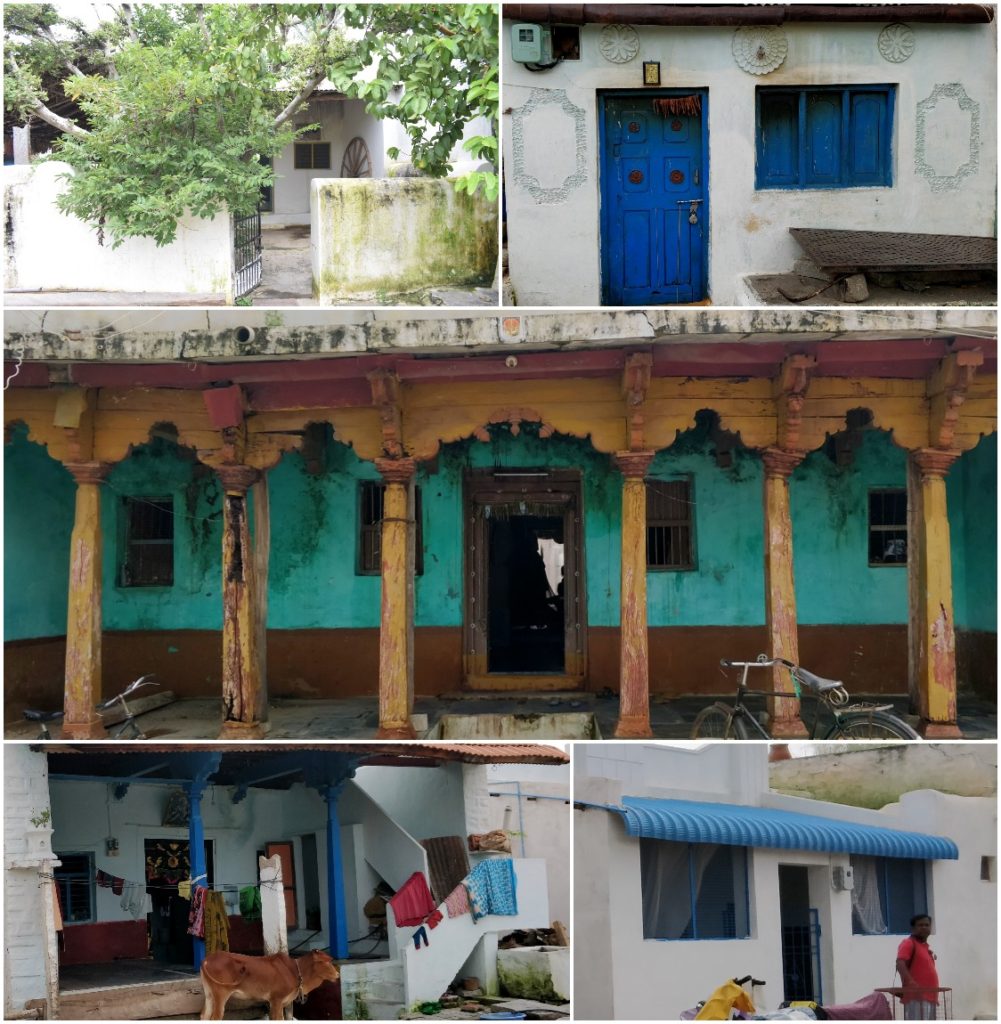
As you walk around Anegundi village, you come across many houses that still retain their vintage aura and are heritage houses.
Top sights in Anegundi – Offbeat places in Hampi
Here is a comprehensive list of 20 Must Visit Places in Anegundi.
- Anegundi Navabrindavanam
- Anegundi fort, Hampi/Vali’s Fort
- 64 pillars temple
- Durga temple
- Ganesha Cave temple
- Pampa Sarovar Near Anegundi
- Pampa Sarovar Lakshmi Temple
- Anegundi Lord Ranganatha Temple
- Jain Temple
- Chintamani Shiva Temple
- Anegundi Hanuman temple/Anjanadri Betta
- Gagan Mahal
- Huchapparayana Matha
- Vali’s Cave
- Subramanyaeshwara temple
- First Gate (Modaline Bagalu)
- Tombs of The Royal Family
- Morya Mane
- Onke Kindi
- Kishkinda Trust
How To Reach Anegundi
Anegundi Map
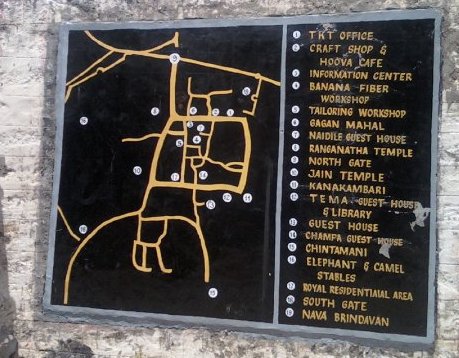
- Anegundi village is situated in the Gangavathi Taluk of Koppal district in the southern Indian state of Karnataka
- Bangalore to Anegundi distance is about 356 kilometres
- Hampi to Anegundi distance is about 19 kilometres
- One can travel to Anegundi by road, rail, or air
- The nearest airport to Anegundi is the Jindal Vijaynagar Airport at Torangallu, which is about 47 kilometres away
If you are planning a trip to Anegundi/Hampi, you can book a cheap flight through TripAdvisor or Agoda or CheapAir or Cleartrip or Makemytrip or Priceline right here. if you are thinking of a road trip to Anegundi from Bangalore or anywhere in India check out the rental car and bus options.
Anegundi Video
Places to Stay in Anegundi – Anegundi Accommodation
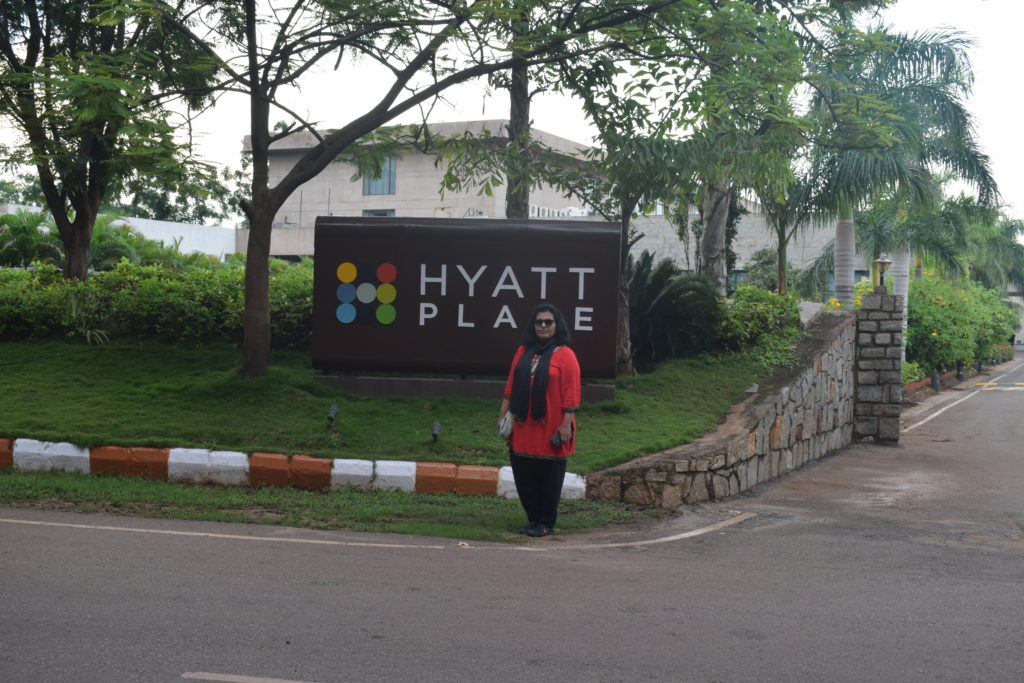
Anegundi offers various accommodation options including some of the most offbeat places to stay in Hampi. There are many Anegundi resorts to choose from. Anegundi homestays are also a good accommodation option. You can also choose to stay either at Hampi hotels or Anegundi hotels.
During our Anegundi travel, we had stayed at the Hyatt Place Hampi which is near the Jindal Vijaynagar Airport. We drove down from Hampi to Anegundi and then back from Anegundi to Hampi. If you are looking at experiencing Anegundi and Hampi with luxury you must stay at the Hyatt Place Hampi property.
For your Anegundi accommodation If you are looking for the best hotels in Anegundi to book, you can do that right here. You can book your hotel in Anegundi through TripAdvisor or Cleartrip or Agoda or Makemytrip or Priceline conveniently right here!
| Click to book the best hotels in Anegundi, Karnataka or best hotels in Hampi |
|---|
| Click to book the best Airbnb in Hampi and Airbnb in Anegundi |
|---|
Anegundi Tourism
There is a lot to explore in and around Anegundi. Hampi too is a treasure house of amazing sights and experiences.
When visiting Anegundi and Hampi you can also avail of package tours that will the important places of interest You can plan your trip and book online places to visit in Anegundi/Hampi.
| Click here to know more and book Best Attractions in Hampi/Anegundi/Karnataka |
|---|
Anegundi Village – FAQ
How do I get from Hampi to Anegundi?
One can take a cab, or autorickshaw to reach Anegundi from Hampi.
How can I reach Nava Brindavana?
Nava Brindavana can be reache by boat from Anegundi.
Which are the Hemakuta hill temples?
The Hemkuta hill temples are all the temples that are scattered around Hampi.
What are the Anjanadri hill temple timings?
The temple is open from morning till dusk. The place is great for a sunset view also.
We hope you liked this Anegundi blog post and it serves as your Anegundi guide. Do let us know if you have any suggestions or information that will help us enrich our content.
Do You Love Traveling?
Do you want to know how to travel the world? We have put together a very useful travel resources page with the best travel tips. Go check it out now.
Thanks for visiting our site Voyager – imvoyager.com and taking the time to read this post!
If you wish to collaborate/work with us then reach us at imvoyager18@gmail.com
We’d love if you’d comment by sharing your thoughts on this post and share this post on social media and with your friends.
Follow our journey on our social media channels:
Facebook Twitter Instagram Pinterest YouTube
60+ Million Users Trust TripAdvisor With Their Travel Plans. Shouldn’t You?
 |
|---|
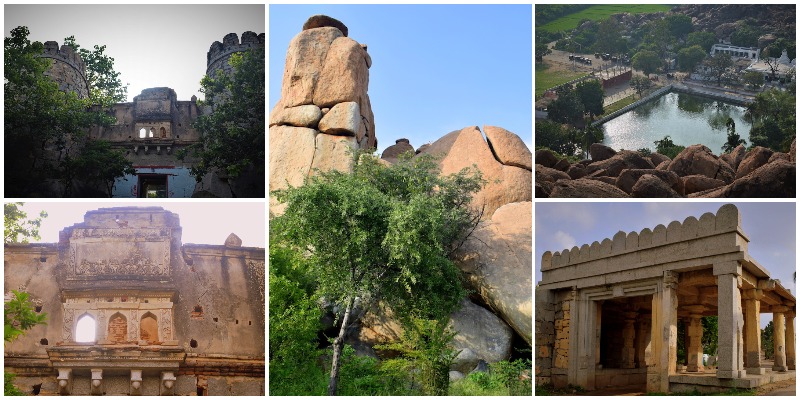
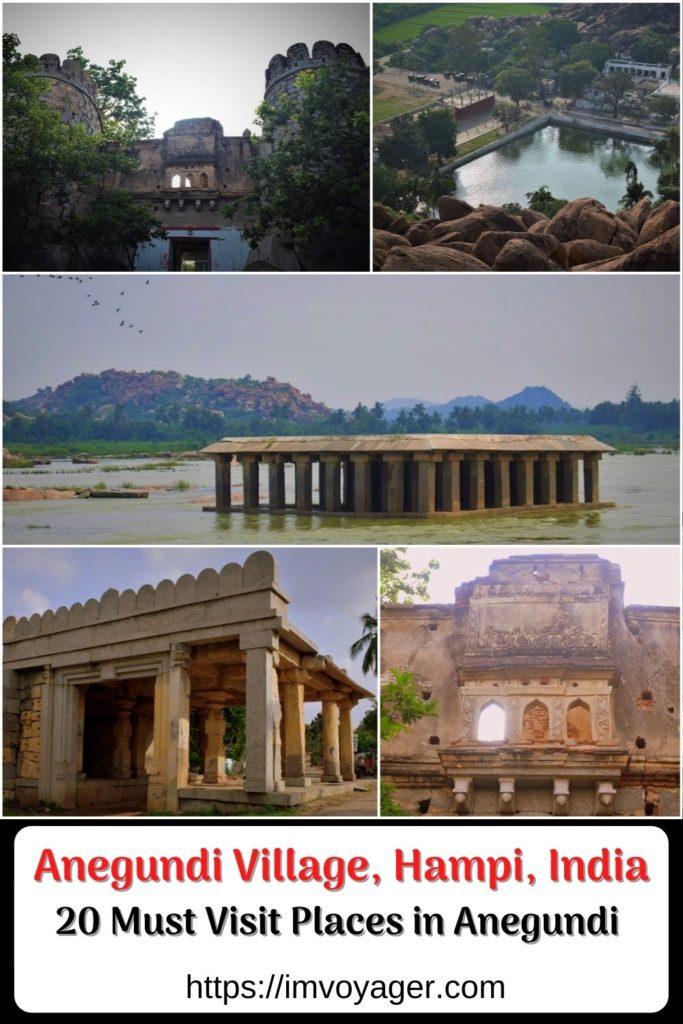 Anegundi village near Hampi in Karnataka, India was once the capital of the Vijayanagara empire and is full of landmarks of history and mythology.
Anegundi village near Hampi in Karnataka, India was once the capital of the Vijayanagara empire and is full of landmarks of history and mythology.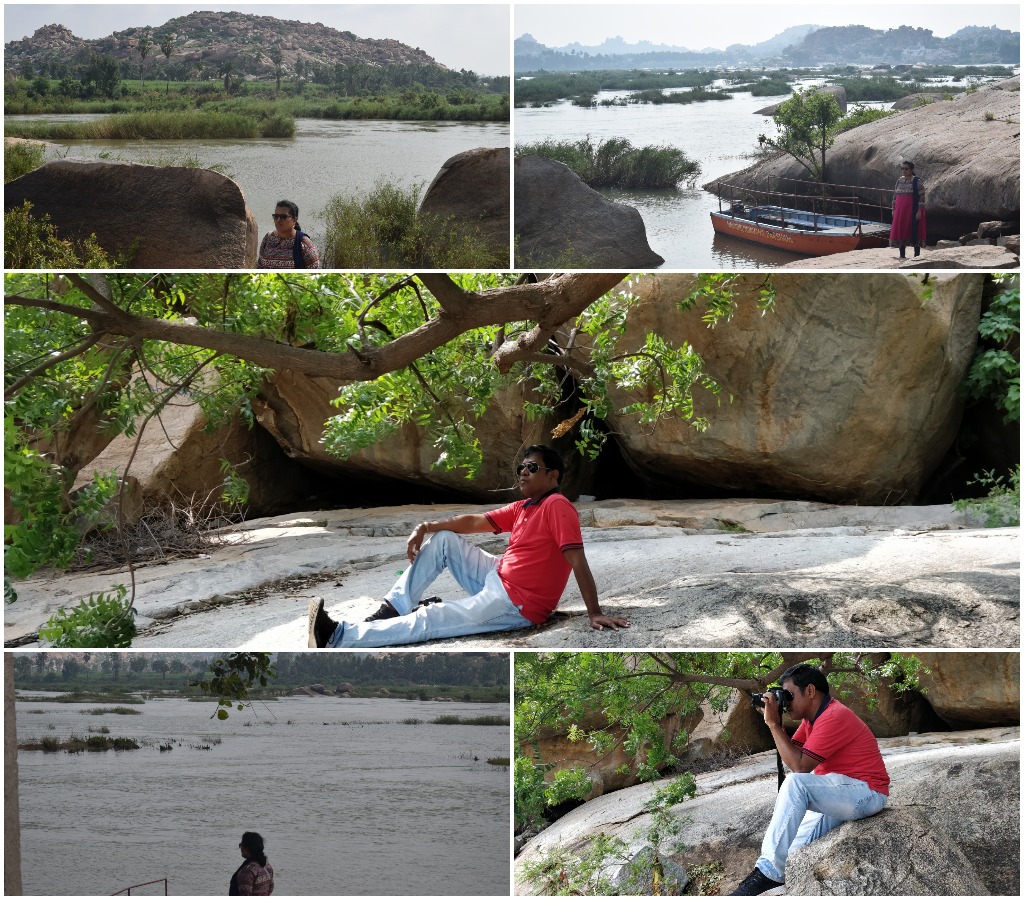


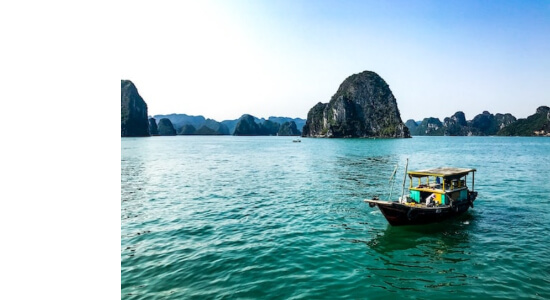

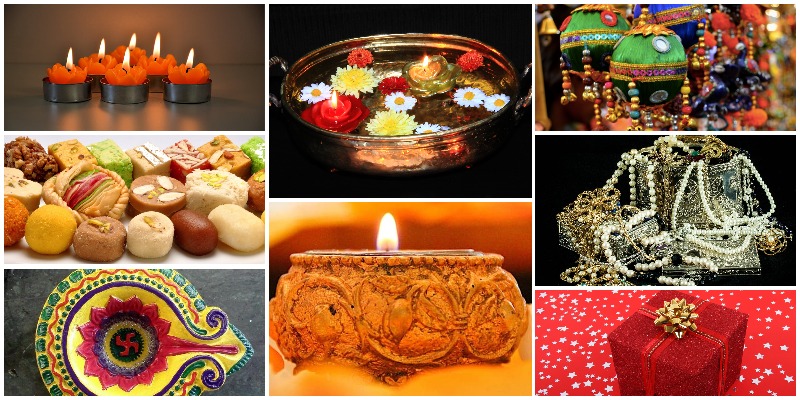
That looks like a fascinating place to visit. I loved the look of the rock temples. And wonderful to see pre-historic art works too. A lovely insightful piece.
Look at these views, Sandy and Vyjay. Wow this place feels so old. Like hallowed antiquity. Some spots ooze the past, with an ancient feel to ’em. This village definitely gives off that old time vibe. Like traveling back century after century. Excellent post.
Wow, this area looks like an amazing place to visit! It looks so ancient and like time has stood still. That rock that looks like a human face is just incredible – it looks like it has been man made!
Combining culture and stunning landscapes, Anegundi Village really sounds like the perfect travel destination for me! So interesting to learn that it’s located on the oldest plateau in the world and also the ancient wall paintings are incredible! Thanks so much for opening up the picture I have of India, it really is so more diverse than I imagined!
Goodness you found so much to explore. I love how the whole area is so lush and green after the rain. It may have swelled the river, but you visited at a beautiful time.
I really love the look of the tree in the Durga temple and all those amazing rock formations.
This is a beautiful place! The rock formation that looks like a face is super weird!! I do love the mythology, that’s really interesting
I am always amazed by how colorful places in India are. I like the ancient rock paintings Onke Kindi. Is it known how old they are?
I ad awlays found Hampi incredibly fascinating and it was on my travel list for a long time while I was living in Pune but I couldn’t make it. I had not heard of Anegundi Village till today and I’m so shocked at my ignorance! There is so much history and legend behind it, not to mention how beautiful it looks. Adding it to my wish list for when I get a chance to travel to Hampi.
On another note, what a great start to your trip to be ferried by Sugriva & Vali!
Truly it is all amazing. We never got a chance to explore Hampi as we were running out of time and as I see, I am sort of glad we skipped it because I would have been very upset to rush through all of the temples, religious sites, and the river. It all look so beautiful and colorful. I particularly love the story of Vali entering the cave while chasing a demon called Mayavi. The religion and mythology of Indian Culture is so intriguing to me.
A visit to Hampi is on my travel bucket list, let’s see when I get to explore it. After seeing your photos I realised visiting Hampi during monsoon would be fun. It is so green and inviting. What according to you is the best time to travel to Hampi?
This place has so much historical importance would certainly like to visit and see the places myself.
What a gorgeous area! I love that it remains so culturally and historically pure and not commercialized. It’s too bad the River was to high to take the boat, I would have loved to do that.
This village looks like a box full of surprises. As I went though the article, the photographs and the descriptions kept on surprising me. Loved the 64 Pillared Mantapa and Pampa Sarovar. The green landscapes and rock formations almost convinced me to visit this place once in my life.
There are so many fascinating places in our country and thanks to travel bloggers like you, one gets to learn about them. Keep writing, I LOVE your posts!
The blog is so detailed and interesting. Almost made me relieve all my travel days. Anegundi Bridge was my fav. There is something about the bridge and the view. The blog is very helpful for anyone planning a visit
Anegundi does sound like a hidden gem and your description of it does absolute justice. Would be interesting to see the Indo-Islamic elements in the Gagan Mahal. What a mix of culture, mythology and history!!
Anegundi village sounds Eureka to me.Such gem with full of epic ramayana tour, I just loved reading it. You know I facinate with Hampi because of it’s tremendous views, history and Ramayana. This article is superb . Pinned it for my hampi and beyond explore purpose.
What a beautiful and historical place HAMPI, A very comprehensive post on Hampi and you cover a lot in a single post. Architecture of Temples is so beautiful. My excitement level just doubled up after going through your blog. Planning to visit at earliest
God damn, I’m loving this post already! So much information and history. I had a gut feeling while reading I would find references of the Ramayana here. 4 billion years and this place still ceases to amaze us all. Also, good going on giving us all information with the amazing pictures.
Your post was an absolutely breathtaking digital trip to me. Such detailed descriptions do help people.to.plan well.
Wow 4 billion years if history and never heard of the place. Thanks for bringing it to fore
Anshu did is amazing. We have been there and just loved it.
The first time we went to Hampi was in 20013 and Anegundi wowed us. Loved the vibe of the place and the history associated with it
The rock paintings just stole my heart. I love finding such paintings that belong to prehistoric times. I have been to Hampi only twice and unfortunately, I have never been to Anegundi and that definitely got added to my list. I will ensure I visit this gem the next time I plan for Hampi.
Anegundi has my heart! It’s a world in its own. I wandered around the village for days and yet it wasn’t enough. Every nook and cranny is filled with so much history it’s hard to keep a track! One can only imagine what life in the Vijaynagar empire would’ve been like, but looking at the structures they left behind – I guess it would’ve been a great one!
Wow, I feel like I learned so much from reading about your adventure! I appreciated all the explanations and insight you gave to the sites’ history. I can only imagine how grand it all must have been in its heyday. Thanks for sharing!